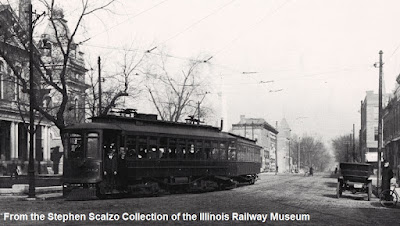BP&J car "Dwight" with a flat car in tow. The BP&J's cars had streetcar styling, but from their size they were unmistakably interurban cars. All photos are from the Stephen Scalzo Collection and are the property of the Illinois Railway Museum.
The Bloomington Pontiac & Joliet
by Stephen M. Scalzo
The Bloomington Pontiac & Joliet Electric Railway was chartered by the state on December 20, 1902 with $100,000 of capital. The company was organized by a group of Pontiac men, led by J.A. Carothers, president of the Pontiac Light and Water Company, and Fred L. Lucas, and built with local capital. It was the intention of the new company to build an interurban from Bloomington to Joliet to connect those terminals with other interurban lines, but in reality the line was never extended beyond Pontiac and Dwight. The designers planned to make a substantial savings by using the novel system of high-voltage alternating current to operate the system.
BP&J car "Dwight" not long after it was delivered from the American factory in St. Louis
BP&J car 201, formerly the "Dwight," location and date unknown
The first interurban, named the Dwight, arrived on February 3, 1905, and the second interurban, named the Pontiac, arrived on July 19th. The first interurban operated over the completed trackage between north Pontiac and Odell on March 15th. However there was a problem in trying to get the Illinois Central and Wabash steam railroads to allow for the construction of a crossing with the interurban on the north side of Pontiac. On March 24th, the city council created a right-of-way from Wabash Avenue across the Wabash tracks so that the interurban could get a crossing, and on April 23rd a crowd rode the first interurban into downtown Pontiac to the southern terminus at the northwest corner of the reformatory. Afterward eight daily interurban trains were operated between Pontiac and Odell.
BP&J car 202, the "Pontiac," at the end of the line in its namesake city.
By 1906 the remaining eight miles of trackage had been completed into Dwight. The line was graded and culverts installed from Pontiac south beyond Chenoa, but the trackage was never installed. A city streetcar was acquired for use on the two mile city line through Pontiac to the reformatory. Later two old elevated railway trailers were obtained. Traffic was heavy in the early years, as dusty paths served as the only roads. Excursions, especially for picnics or for the Chautauqua in Pontiac, were common. A dance hall at Interurban Park near Odell attracted many persons. Competition came from the Chicago & Alton Railroad which operated 13 daily steam passenger trains through Pontiac, and the Illinois Central and Wabash which each operated four trains.
BP&J car 201, formerly the "Dwight," northbound at Main and Madison in Pontiac.
The traffic potential of the company was very limited, and confined to passenger service which operated with two hour headways. Highway construction and World War I inflation squeezed the company. In June 1920 the Illinois Public Utilities Commission granted the company permission to increase fares to three cents a mile; however another ruling by the commission provided that tickets had to be sold for 2.5 cents a mile. In early 1921, the company petitioned for a three cent a mile fare regardless of a ticket sale or cash fare, with permission being given on February 1st.
BP&J car 202 is in Pontiac, southbound on Main turning west onto Washington, in 1910. It is towing one of the ex-New York elevated trailers. The courthouse to the left is still there.
This history was written by the late Stephen M. Scalzo and was edited and laid out by Frank Hicks. Thanks go to Ray and Julie Piesciuk and to Richard Schauer for maintaining the Scalzo collection and making these materials available for republishing.
Bloomington Pontiac & Joliet Equipment Roster
Built 1905 by American Car Company on ord#569 as Dwight
Length 41'8" - Weight 58,000 lbs - 40 seats - Brill 27E1 trucks - 4 x GE 604 motors - T33 control
Fitted for AC or DC operation
202
Built 1904 as a demonstrator for the St. Louis World's Fair (builder unknown), delivered in 1905 as Pontiac
251-252
Thirdhand Manhattan Railway elevated trailers built c1880 and purchased in 1908 from unknown intermediary
Length ~45' - Weight 16,000 lbs - 40 seats
301
Built 1895 by American Car Company for Citizens Railway of St. Louis
Sold to United Railways, resold 1906 to Chicago Union Traction as CUT 3866
Purchased by BP&J in 1913
Length 36'2" - 36 seats - St Louis 21 trucks - 2 x WH 56 motors - K-11 control
A freight motor was also purchased in 1908 but there is no solid information on it.
A single-truck city car numbered 33 built by McGuire-Cummings in 1912 was leased from the Public Service company's Streator lines in 1921 but was soon returned.
One of the ex-Manhattan Railway elevated cars survived as a shed in a backyard in Pontiac at least as late as the mid-1940s. McLean County Museum of History photo.








2 comments:
Was there any financing or interest in the BP&J by Illinois Traction System folks? It would have made a nice fill to the missing link between Joliet and Bloomington, connecting the larger interurban from St. Louis to Chicago.
O. Anderson
No. The IT had their own plans for connecting to the IVDIV via Streator. As Scalzo says, the BP&J was locally promoted, then became part of the Fisher system, and then a subsidiary of NIPS, the Insull empire. It certainly wasn't what we usually think of as an Insull interurban!
Post a Comment